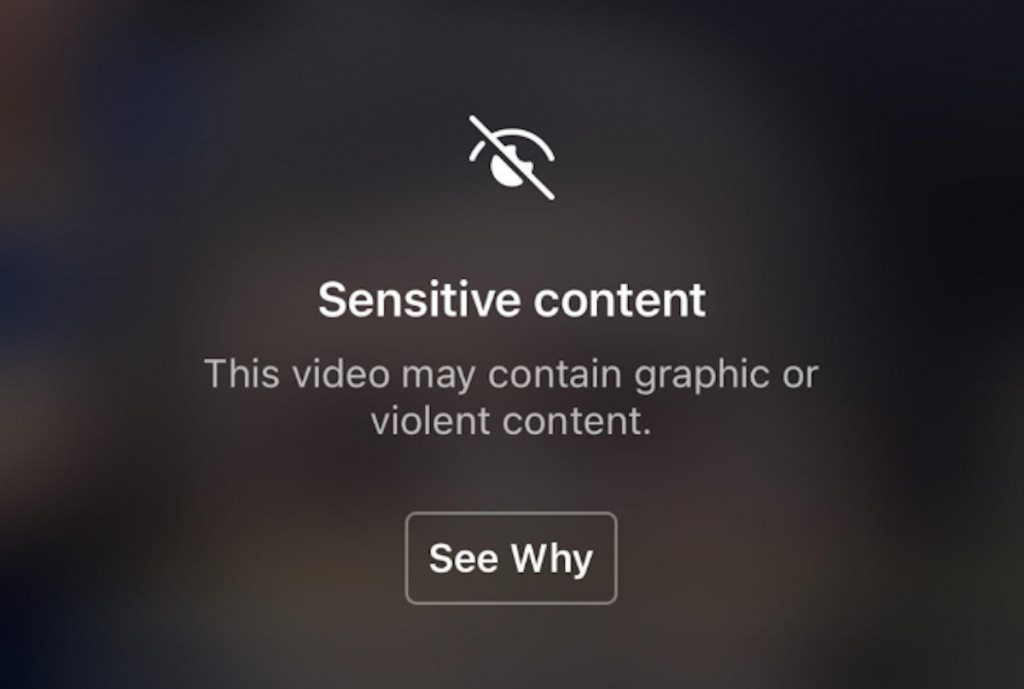Set off warnings are used to assist people keep away from or emotionally put together for content material that will trigger them emotional or psychological misery (Cares et al., 2019; DeBonis, 2019; George & Hovey, 2020). Though well-intentioned, the proof base and particular person opinions in the direction of the advantages of set off warnings are combined.
Set off warnings can go by different names, similar to content material warnings, content material advisories, and content material notes, and are recurrently utilized by TV and conventional media shops (Charles et al., 2022). Their newer adoption by on-line media channels and particular person content material creators has introduced into query their appropriateness, helpfulness, and in some instances, their potential for hurt.
Critics level to findings that recommend they introduce anticipatory anxiousness (Bellet et al., 2018; Gainsburg & Earl, 2018), undermine the resilience of content material customers and their capability to sit down with distressing data, and over-sensitise people to difficult, however essentially vital, subjects (Lukianoff and Haidt 2015; Bellet et al. 2018).
Others argue that they supply people with a way of company and permit them to make energetic decisions about whether or not to have interaction with or keep away from, sure sorts of content material (Cares et al. 2019; George and Hovey 2020; DeBonis 2019).
With restricted analysis, combined findings, huge particular person variability in views, and a scarcity of consensus for what constitutes a superb set off warning and when it’s required, a latest meta-analysis of the efficacy of set off warnings was a really welcome and well timed addition to this ongoing debate (Bridgland et al., 2023).

Variations in the best way content material warnings have been outlined, measured, and carried out make it tough to check their efficacy.
Strategies
Research investigating participant psychological or psychophysiological reactions or behaviours to set off warnings have been included on this meta-analysis. Set off warnings needed to particularly notify members that the content material they have been about to view might elicit recollections or feelings related to previous experiences. Set off warnings that have been basic in nature (e.g., PG-13 warnings) have been excluded. Research additionally needed to measure outcomes regarding a number of of the next: response have an effect on, avoidance, anticipatory have an effect on, and academic outcomes (i.e., comprehension).
407 articles have been initially recognized as assembly the search standards. After eradicating 171 duplicate papers, 236 abstracts have been screened in opposition to the inclusion standards. Of those 236 abstracts, solely 20 research have been capable of be included within the full-text screening.
The total-text screening recognized gaps inside a few of these research (i.e., offered warnings that didn’t meet the definition of a set off warning as outlined inside this evaluation, and didn’t measure the identical outcomes), leading to a complete of 12 research that might be included within the meta-analysis. Extracted psychological and behavioural outcomes have been then organised into 4 classes: anticipatory have an effect on; avoidance; comprehension and response have an effect on. A 3-level meta-analysis with nested results was then carried out.
Outcomes
Every of the 12 included research have been printed after 2018. Most research used a single-session design the place members have been randomised to obtain a content material warning or a management situation. Nearly all of research additionally measured their main outcomes instantly after members have been uncovered to distressing content material or a content material warning (or each). The authors reported that included research have been predominantly carried out in WEIRD societies (Western, Educated, Industrialised, Wealthy, and Developed) and thus lacked various cultural views. Most samples comprised trauma survivors: solely two impact sizes within the meta-analysis excluded trauma survivors, and a number of research completely examined trauma survivor experiences.
- Eleven of the twelve included research have been unanimous of their conclusion that set off warnings didn’t have a significant affect on:
- members’ emotional response to damaging materials (outlined as ‘response have an effect on’),
- avoidance behaviours (with some research reporting that content material warnings fostered extra engagement, not much less) or
- studying outcomes.
- Outcomes additionally indicated that content material warnings persistently led to a quick enhance in misery because of members anticipating distressing content material (outlined as ‘anticipatory anxiousness’).
- Solely one of many twelve research kept away from concluding that content material warnings are ineffective, and as a substitute highlighted that there are numerous competing advantages and threat components which might be tough to disentangle.
General, the outcomes of this evaluation don’t assist that content material warnings are useful, and they don’t seem to help people in emotionally making ready for, and avoiding, distressing content material. This raises questions on if, when, and the place content material warnings are most useful for various people.

Outcomes recommend that content material warnings aren’t as useful as we predict they’re.
Conclusions
The findings from this meta-analysis present a compelling argument that set off warnings don’t meaningfully affect emotional response to distressing materials, behavioural avoidance, or understanding of the content material being seen. Actually, outcomes recommend that generally content material warnings enhance anticipatory misery and lead to a interval of discomfort previous to publicity.
Though it’s acknowledged that these findings have predominantly been drawn from western, non-clinical, grownup samples and can’t be generalised to all people, the outcomes increase quite a lot of vital questions. Future areas of investigation ought to embrace the potential advantages of content material warnings for cohorts with particular trauma experiences; how tradition might affect the acceptability and affect of content material warnings; in addition to the differential impacts for particular teams similar to neurodiverse people and younger individuals. Additional, the included research solely checked out fast, short-term reactions to warnings. Little is understood relating to the longer-term impacts and the way cumulative publicity to distressing content material (and in flip, content material warnings) impacts people.
From the current meta-analysis, it may be concluded that for predominantly white adults in western, developed nations, content material warnings serve little objective. Nonetheless, this can’t be the top of the dialog as a result of many extra people than have been represented on this meta-analysis are uncovered to distressing content material recurrently.

Future analysis should think about the differential affect of content material warnings on people from black, ethnic, and indigenous backgrounds.
Strengths and limitations
This examine was the primary meta-analysis of the psychological results of content material warnings. The authors be aware that earlier analysis findings have been combined, and due to this fact, there may be potential for proponents of both ‘aspect’ of the talk to solely cite research that assist their views. As suicide prevention researchers centered on how younger individuals use social media for suicide and self-harm associated communication, we argue that this meta-analysis is a vital scientific contribution to the literature, nonetheless, many questions stay unanswered with respect to the potential utility of content material warnings.
Entrance of thoughts is the truth that anecdotally, many younger individuals have instructed us that they assume content material warnings are useful and they’d choose content material warnings be used previous to being uncovered to self-harm and suicide-related content material on-line. On the one hand, this presents a difficult situation the place the perceptions and preferences of younger individuals are in battle with the proof on this evaluation. Nonetheless, it is very important be aware that the research included on this meta-analysis centered on adults, and developmental variations might play an vital function within the usefulness of content material warnings. On the subject of on-line publicity, younger individuals are amongst these more than likely to come back throughout distressing content material because of the period of time they spend on-line, and the best way present algorithms work on many in style platforms. As such, there may be an pressing want for future research to contemplate age-appropriate methods for giving younger individuals the selection in regards to the kind of content material they have interaction with. Moreover, the character of this examine meant that it didn’t embrace qualitative analysis into the views’ and views of younger individuals. It’s potential that social media customers might report experiencing content material warnings as qualitatively useful, even the place elevated anticipatory have an effect on and combined behavioural outcomes (e.g. avoidance or the ‘forbidden fruit’ impact) are recognized. Actually, anticipatory anxiousness might, at instances, serve an vital objective. We argue that the views of social media customers, and notably younger individuals, might be a vital addition to this dialog going ahead.
Subsequent, it’s crucial that culturally and linguistically various communities are invited to contribute to analysis into the impacts and advantages of content material warnings. This can be a limitation to the present physique of literature and thus the meta-analysis was not capable of look at the differential affect of content material warnings throughout cultural teams. For instance, in Australia we all know that warning viewers that they might be uncovered to details about somebody who has died is especially vital for a lot of First Nations communities. For some Aboriginal and Torres Strait Islander Australians, being uncovered to photographs or names of people who’ve died can’t solely trigger misery however can even violate strongly held cultural prohibitions (AIATSIS, 2022). This is only one instance of many nuanced and sophisticated concerns that must be made when contemplating using content material warnings and the way their that means and worth might differ throughout cultures and communities.

Analysis must discover the affect of set off warnings on youngsters and younger individuals, as developmental variations might affect their usefulness.
Implications for observe
General, we argue that the means distressing data is shared on-line is extra vital than whether or not or not a content material warning is included. Content material warnings have the potential to turn out to be a ‘tick-box train’ and should disincentivise customers from sharing delicate data in secure methods. For instance, the #chatsafe pointers (the world’s first pointers developed to assist younger individuals to speak safely on-line about self-harm and suicide) encourage younger individuals to pause earlier than posting and think about the data they’re posting, and what the implications could also be for themselves sooner or later and people who they care about. #chatsafe additionally encourages younger individuals to keep away from detailing strategies of self-harm and suicide (what, how, the place and when) and they’re inspired to observe this steering no matter whether or not a content material warning is used. The just lately up to date #chatsafe pointers step younger individuals by methods to share their tales of self-harm and suicide in secure and useful methods for themselves and their on-line buddies (Robinson et al., 2023). Concerns for the way details about different subjects will be shared safely would additionally contribute to safer on-line interactions, and scale back the duty positioned upon content material warnings to maintain everybody secure.
Findings of this meta-analysis additionally assist the significance of discussing on-line content material in offline settings and in offering applicable assist to people uncovered to dangerous materials. That is notably vital for clinicians, or these working with younger individuals, when contemplating and discussing the character and amount of distressing on-line content material younger individuals are uncovered to every day.
Lastly, an vital query stays regarding the language used when referring to set off warnings – ought to or not it’s content material warnings, content material discover, content material advisory or one other time period? Some argue that the time period ‘set off warning’ denotes that the data being shared ought to be triggering or traumatic in a roundabout way, and this could perpetuate already extremely stigmatised subjects. Totally different phrases are utilized in observe and all through the literature, and it is very important perceive the views of neighborhood members who such content material warnings are designed to help. The views of younger individuals with lived expertise of trauma must be paramount on this dialog.
The findings of this paper have made an vital contribution to what must be an ongoing dialog. Extra nuanced understandings of the place, when, and the way content material warnings assist customers to make acutely aware choices in regards to the data they share and devour on-line will contribute to safer interactions and in the end guarantee the security of each content material creators and customers.

A way more nuanced understanding of the place, when, and the way content material warnings assist people is required.
Helpful hyperlinks
Assertion of pursuits
Dr Louise La Sala, Mr Charlie Cooper and Professor Jo Robinson are researchers on the #chatsafe venture, a program of labor designed to assist younger individuals to speak safely on-line about self-harm and suicide.
Hyperlinks
Main paper
Different references
Robinson J, Thorn P, McKay S, Hemming L, Battersby-Coulter R, Cooper C, Veresova M, Li A, Reavley N, Rice S, Lamblin M, Pirkis J, Reidenberg D, Harrison V, Skehan J, La Sala L. #chatsafe 2.0. updated guidelines to support young people to communicate safely online about self-harm and suicide: A Delphi expert consensus study. PLoS One. 2023 Aug 2;18(8):e0289494. doi: 10.1371/journal.pone.0289494.
AIATSIS (2022). Cultural sensitivity.
Bellet, B. W., Jones, P. J., & McNally, R. J. (2018). Trigger warning: Empirical evidence ahead. Journal of Conduct Remedy and Experimental Psychiatry, 61, 134–141.
Cares, A. C., Franklin, C. A., Fisher, B. S., & Bostaph, L. G. (2019). “They Were There for People Who Needed Them”: Student Attitudes Toward the Use of Trigger Warnings in Victimology Classrooms. Journal of Legal Justice Schooling, 30(1), 22–45.
Charles, A., Hare-Duke, L., Nudds, H., Franklin, D., Llewellyn-Beardsley, J., Rennick-Egglestone, S., Gust, O., Ng, F., Evans, E., Knox, E., Townsend, E., Yeo, C., & Slade, M. (2022). Typology of content warnings and trigger warnings: Systematic review. PloS One, 17(5), e0266722.
DeBonis, Ok. (2019). Trigger Warnings in Medical Education. Tutorial Drugs: Journal of the Affiliation of American Medical Faculties, 94(6), 749.
Gainsburg, I., & Earl, A. (2018). Trigger warnings as an interpersonal emotion-regulation tool: Avoidance, attention, and affect depend on beliefs. Journal of Experimental Social Psychology, 79, 252–263.
George, E., & Hovey, A. (2020). Deciphering the trigger warning debate: a qualitative analysis of online comments. Educating in Greater Schooling, 25(7), 825–841.

